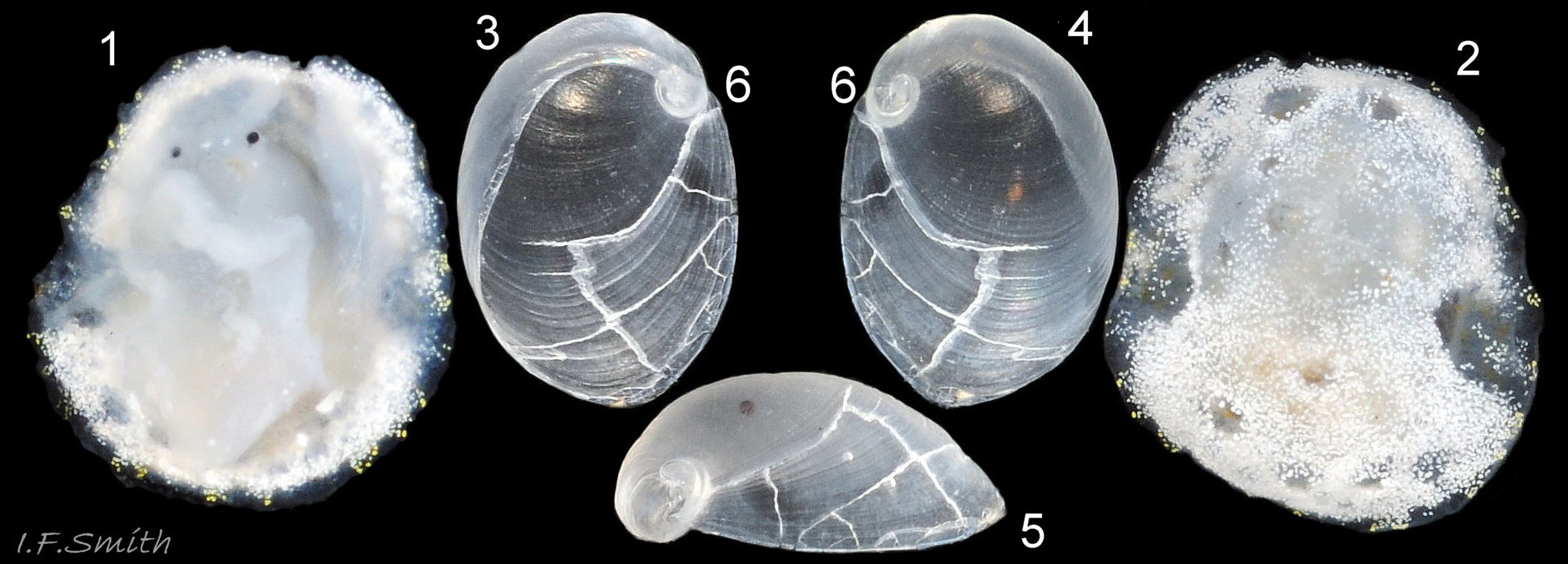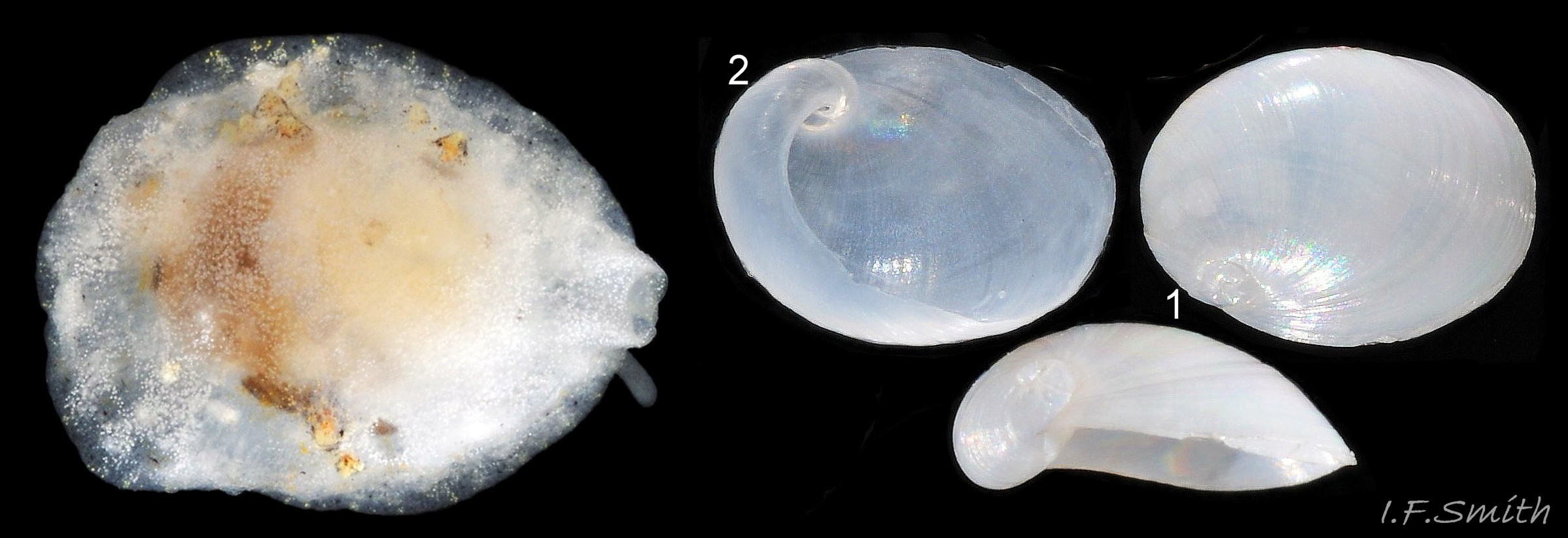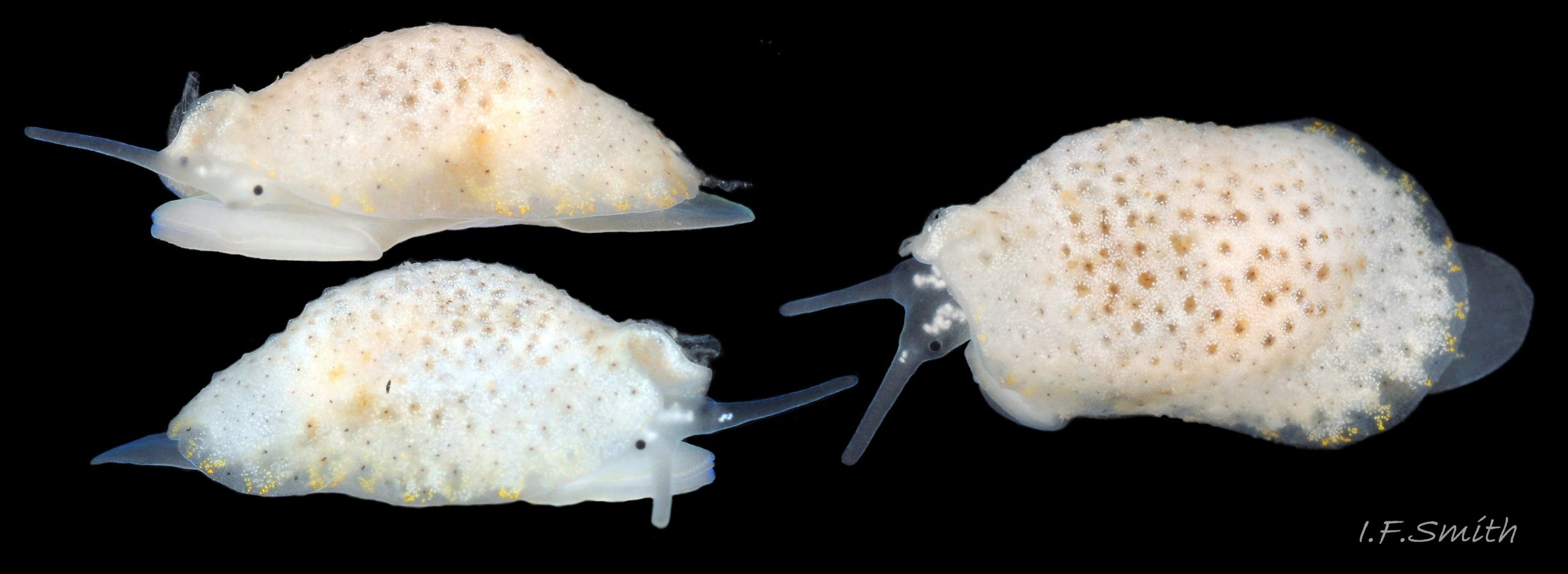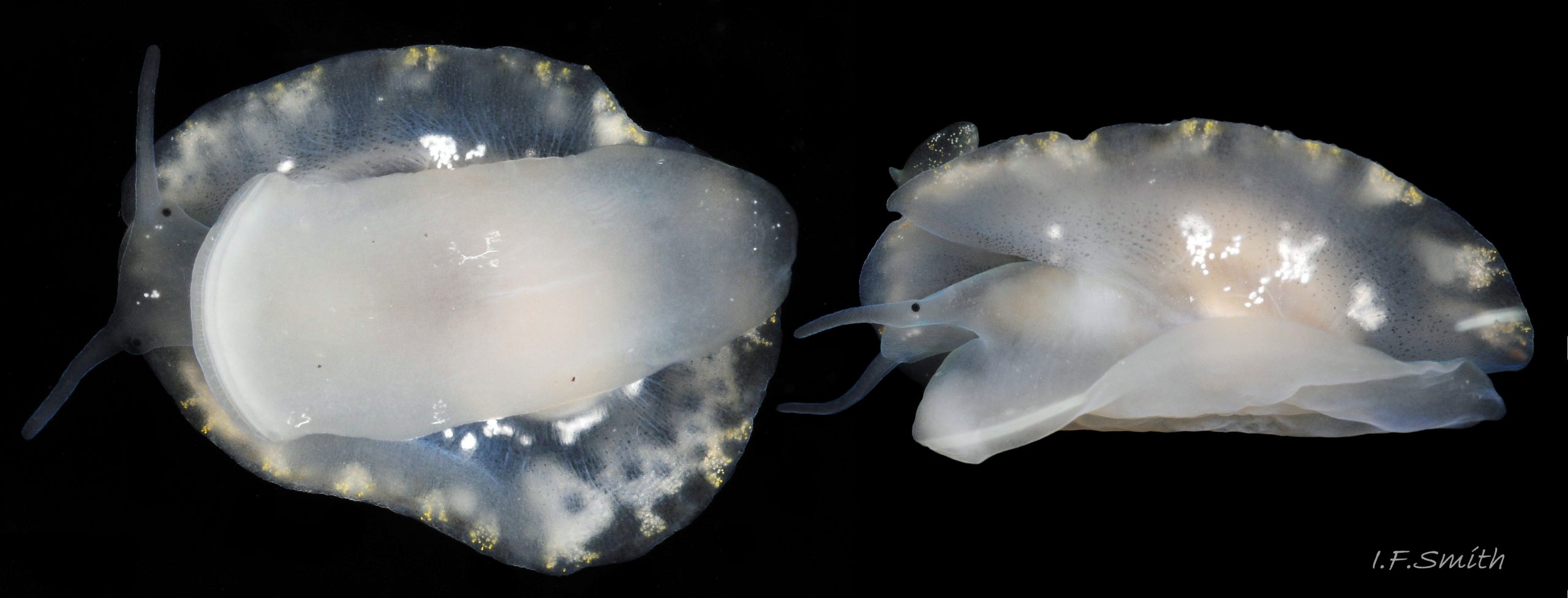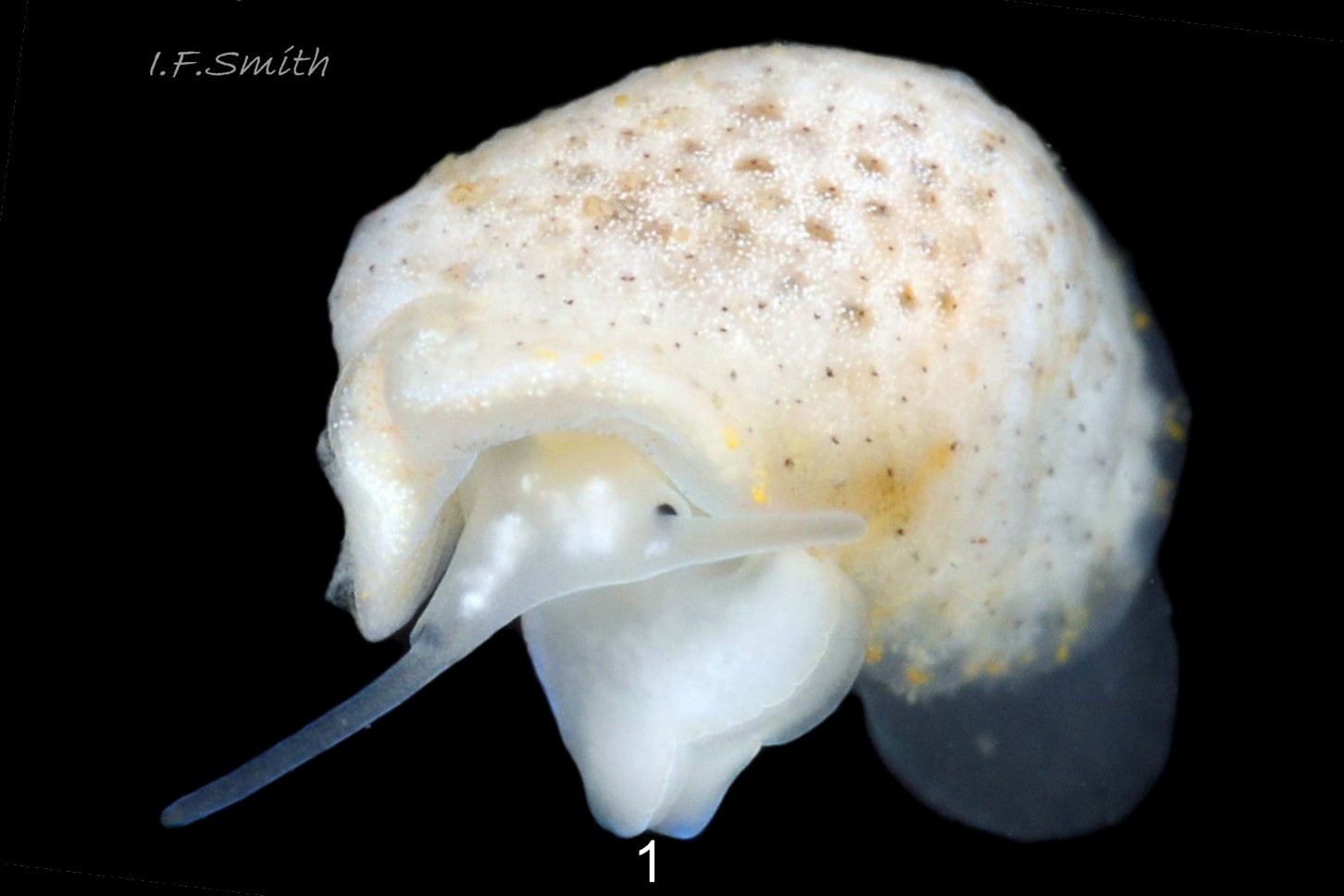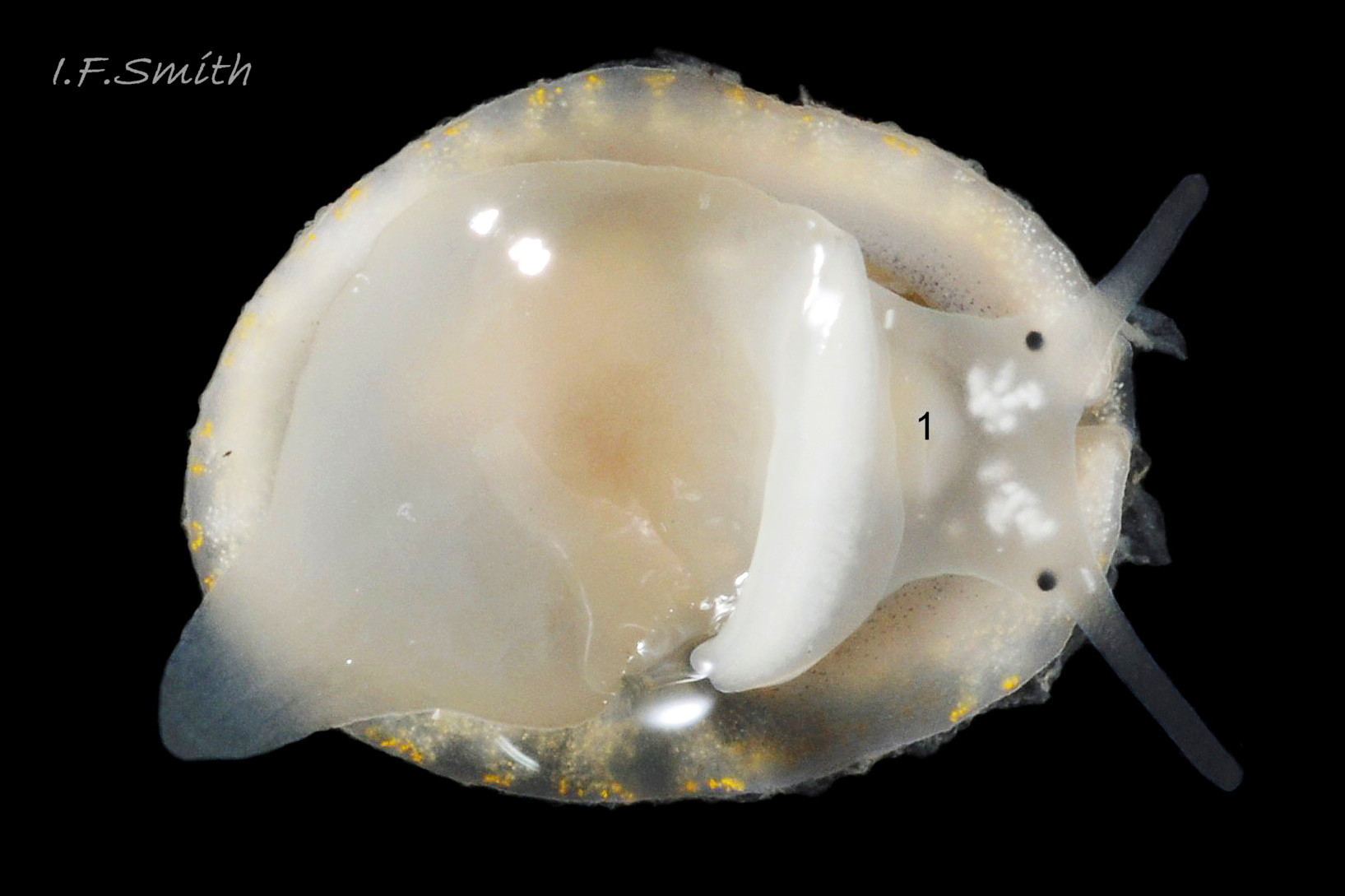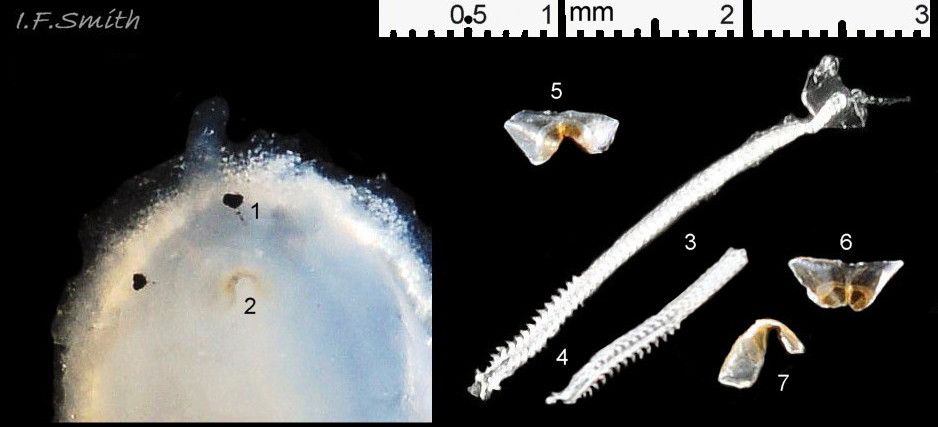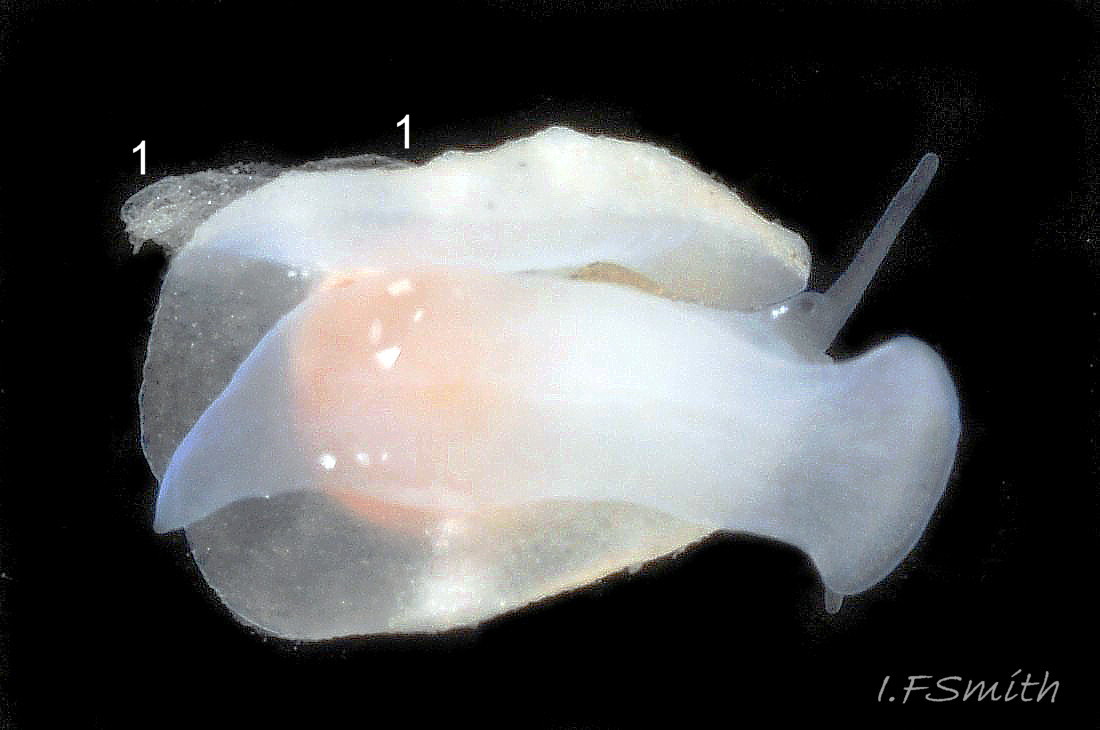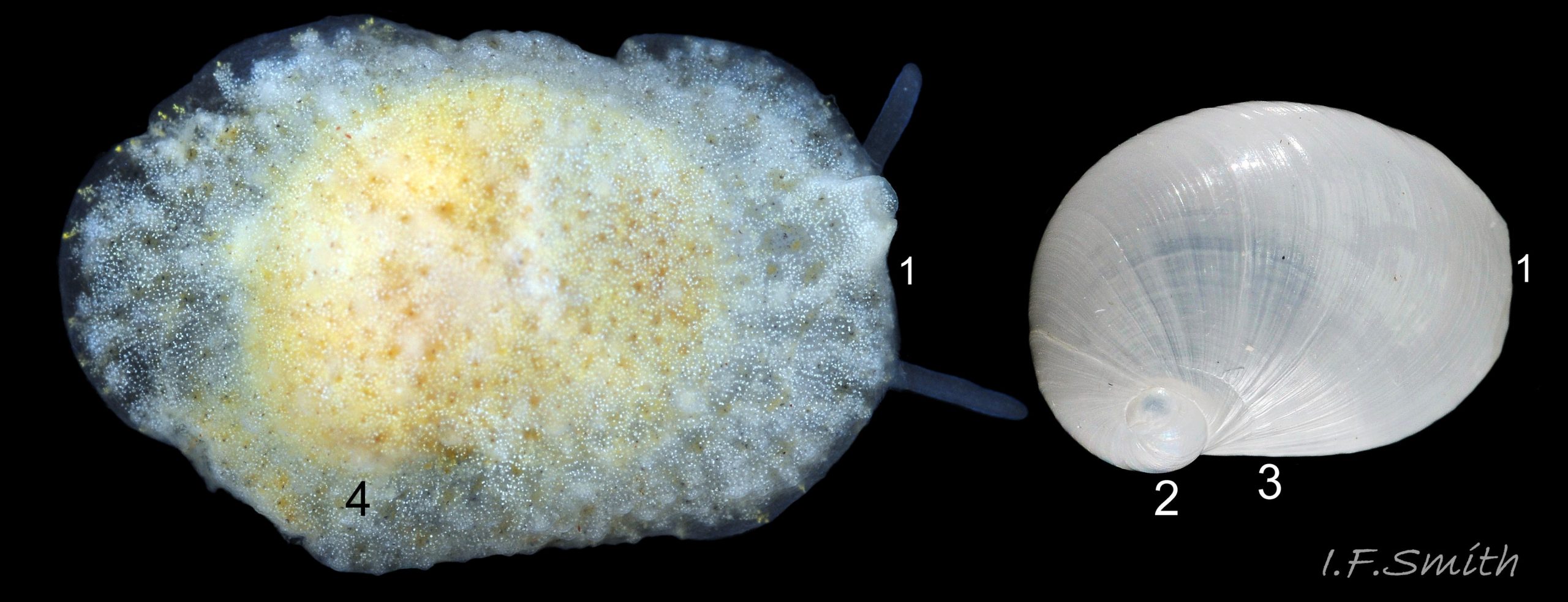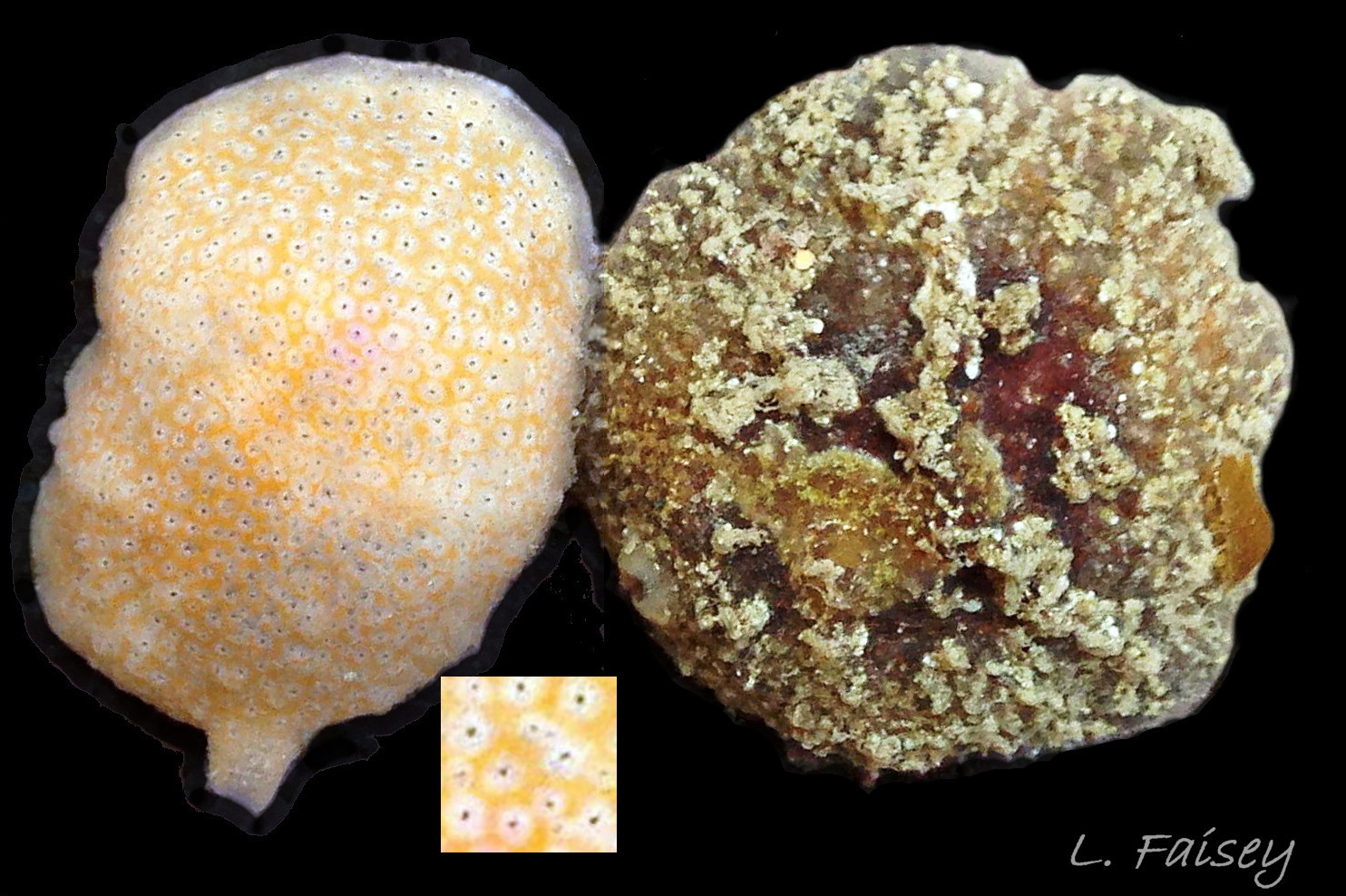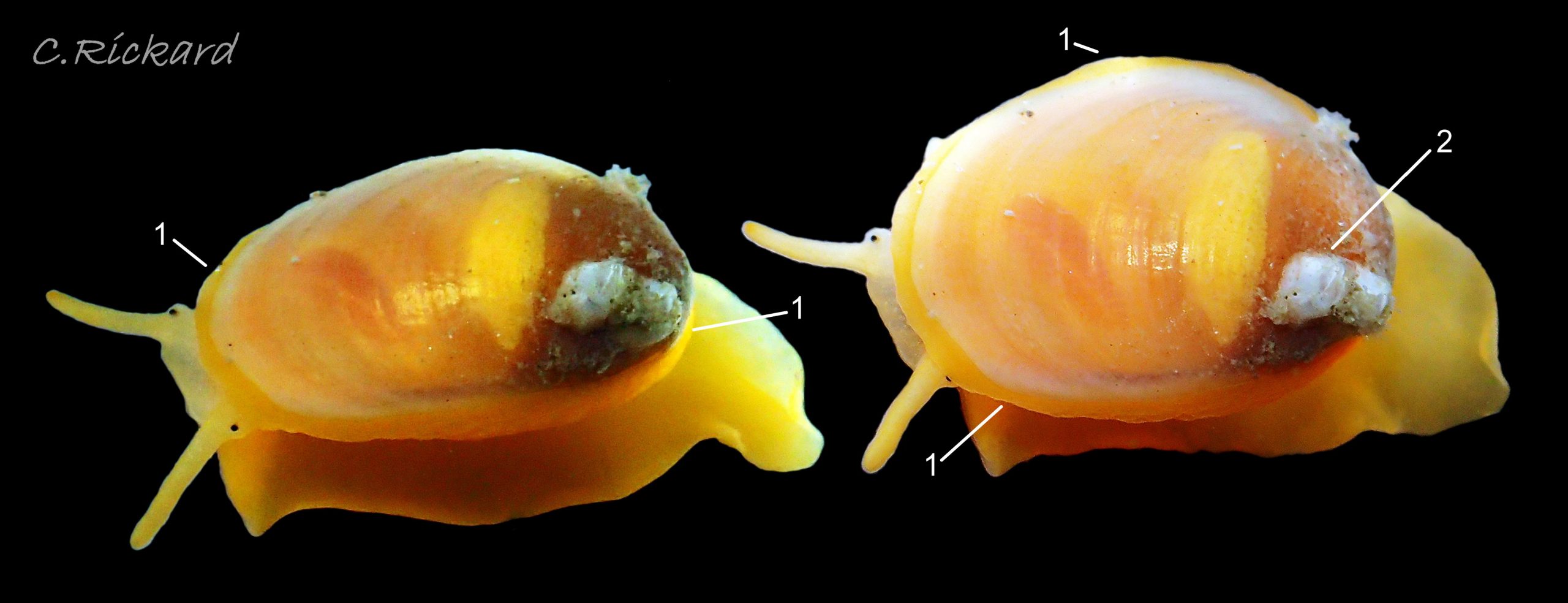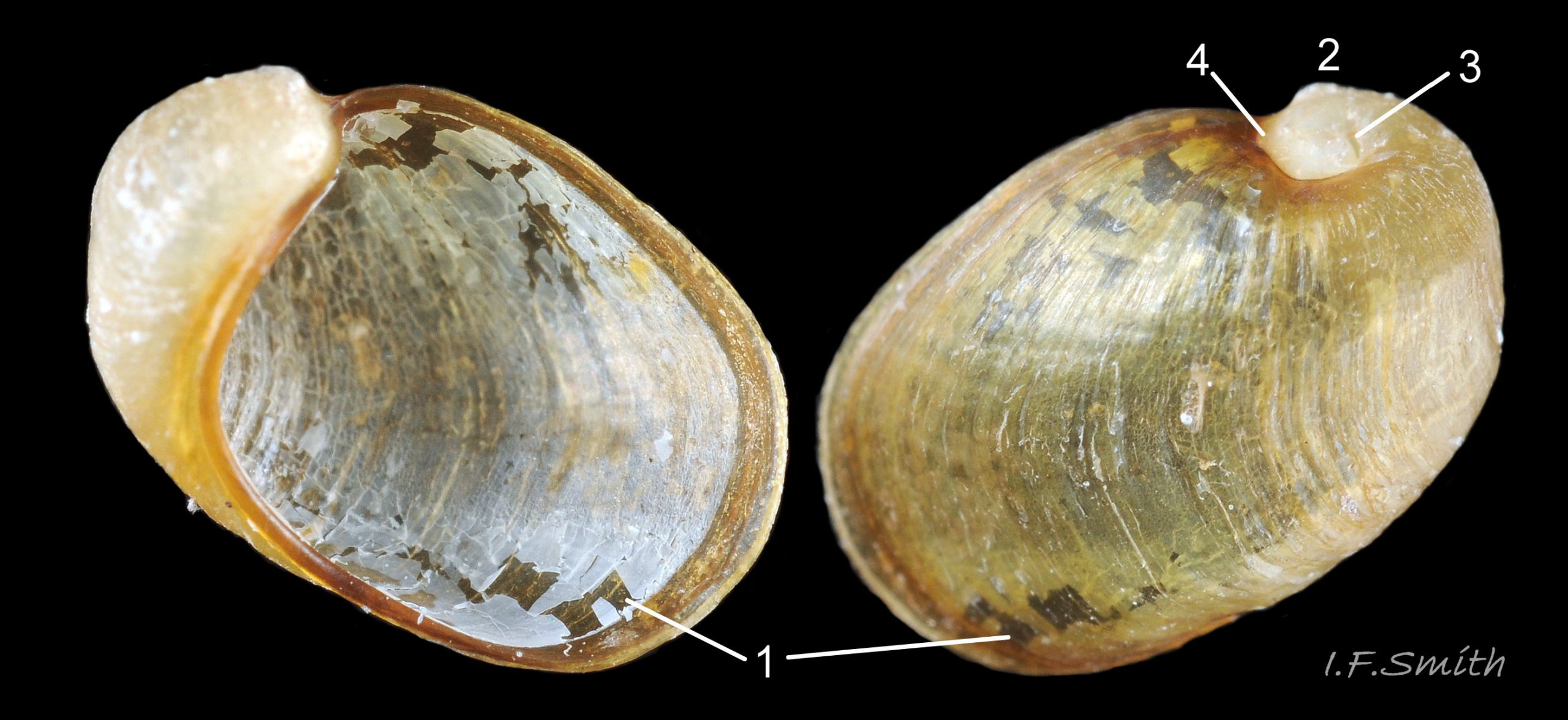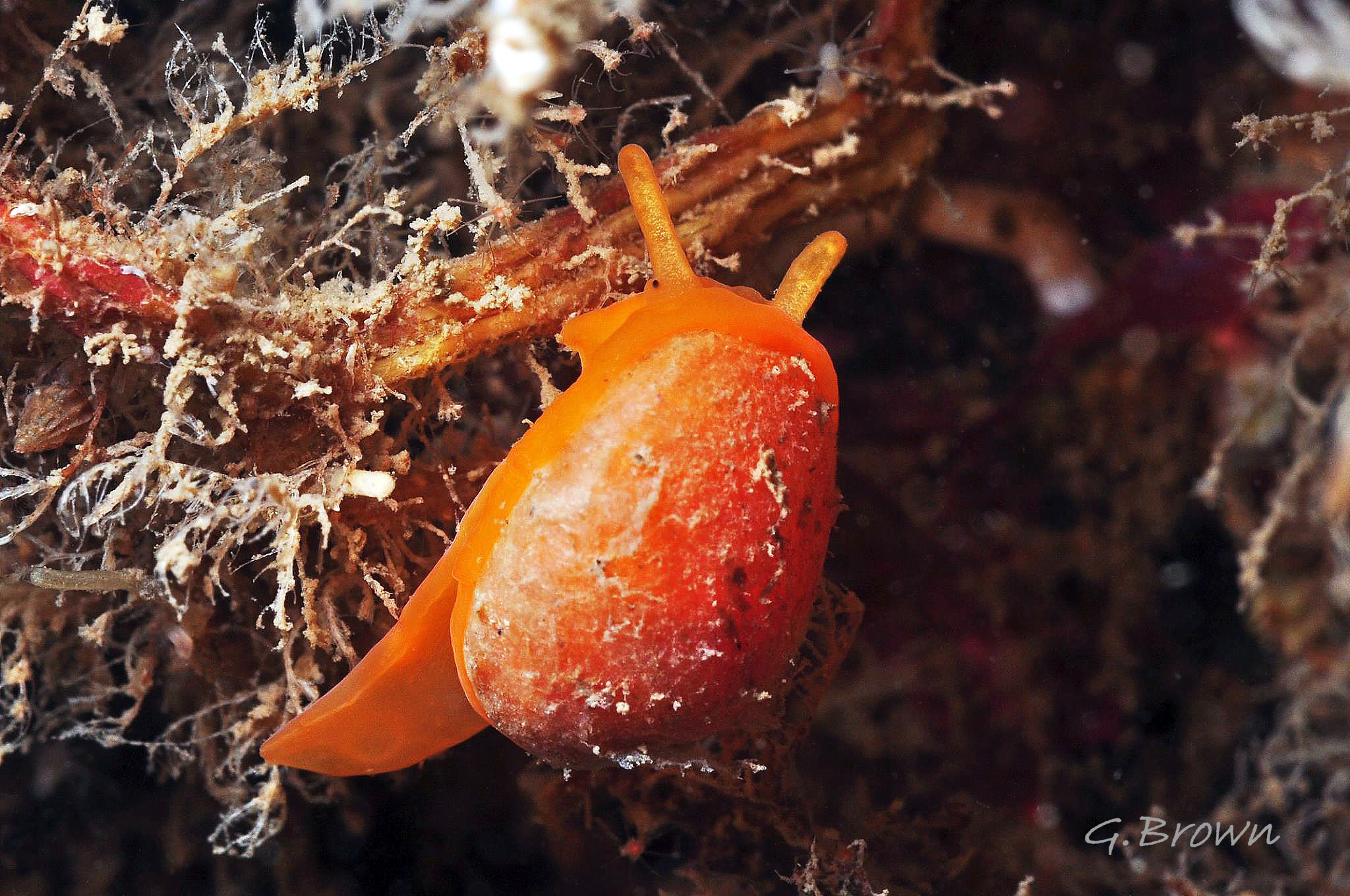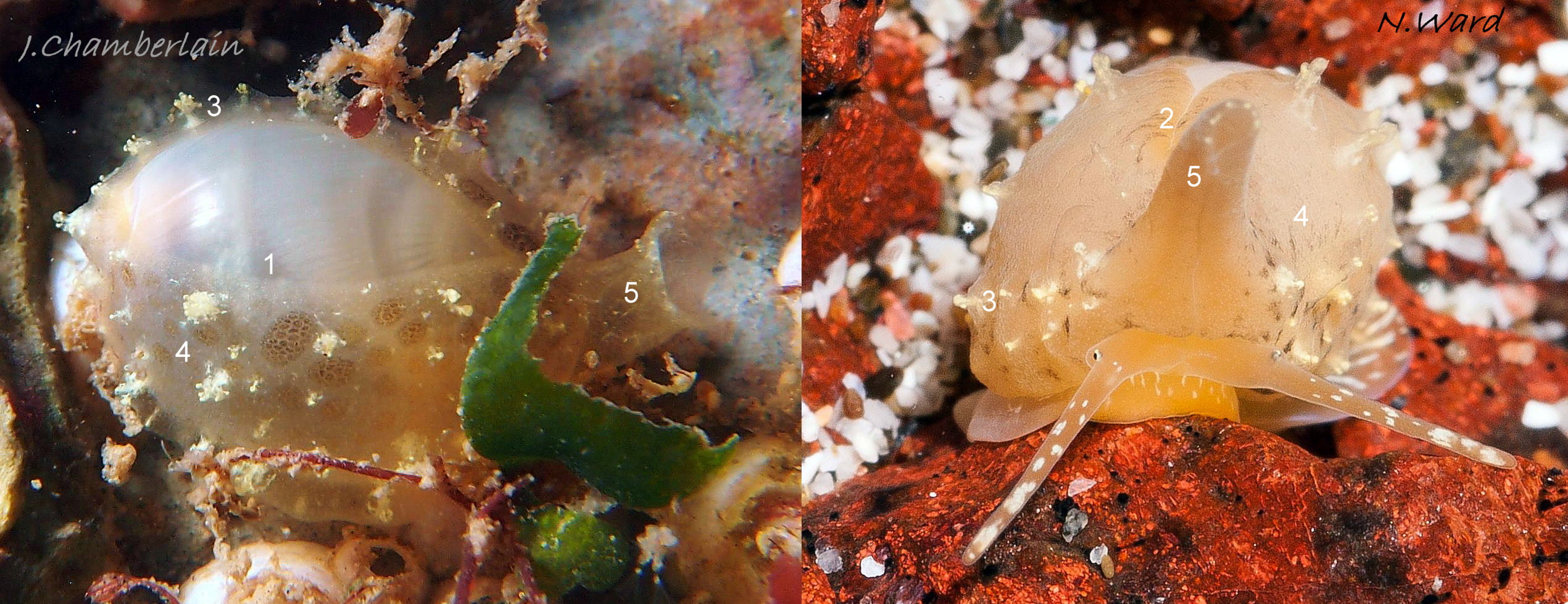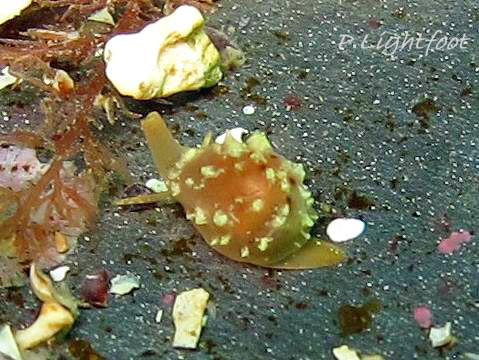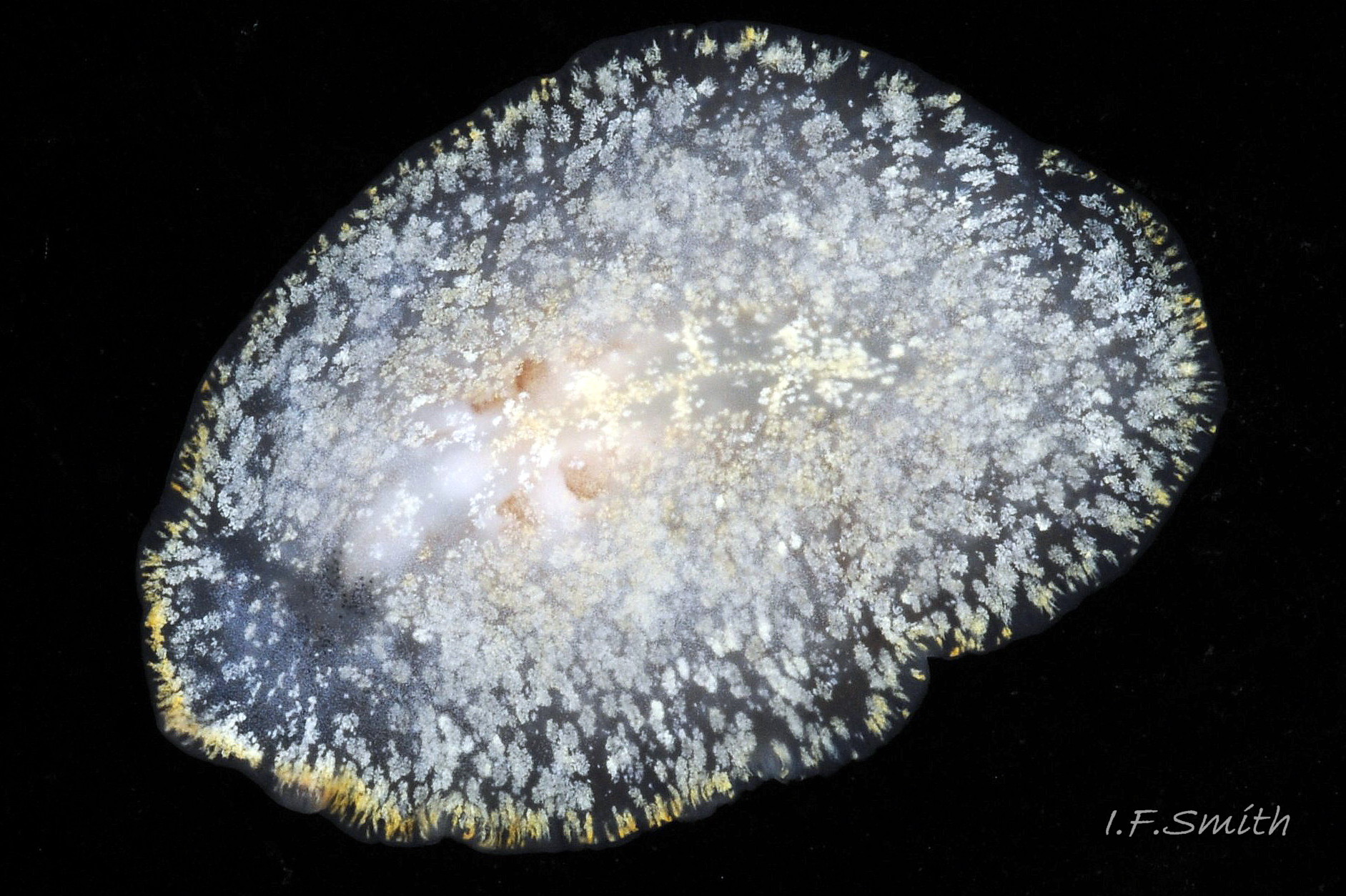Click image to enlarge with full caption. Main text below slider.
Lamellaria latens (O. F. Müller, 1776)
PDF version at www.researchgate.net/publication/350957294_Lamellaria_lat…
Current taxonomy: World Register of Marine Species (WoRMS) www.marinespecies.org/aphia.php?p=taxdetails&id=140172
Synonyms:Bulla latens O. F. Müller, 1776; Lamellaria tentaculata Montagu, 1816; Lamellaria perspicua var. lata Jeffreys, 1867.
Meaning of name: Lamellaria (Latin) = like a thin plate or leaf (referring to the mantle).
latens (Latin) = hidden (referring to shell)
Vernacular: Klein glasmuitje (Dutch);
GLOSSARY below.
Introduction
Lamellaria are dioecious gastropods in subclass Caenogastropoda (“Prosobranchia” in 20th Century publications), closely related to European cowries, Trivia species ( 01 Lamellaria latens, rather than hermaphrodites in subclass Heterobranchia (formerly “Opisthobranchia”) like the majority of seaslugs. But, having a concealed internal shell into which they cannot retreat, they qualify as ‘seaslugs’, a vernacular, non-scientific term. (Terms explained in glossary below.)
Shell description
The weakly calcified, easily fractured, translucent shell ( 02 Lamellaria latens ) is permanently enclosed when alive by the fused right and left mantle lobes. The longest shell dimension is up to 5 mm and its width to 4 mm. The very large body whorl forms over 90% of the shell. Two small spire whorls meet at a distinct suture. The spire is inconspicuous as it does not protrude beyond the outer lip of the aperture so when the shell is examined in plan-view it forms a smooth uninterrupted ellipse ( 03 Lamellaria latens ). The widely-open, weak lipped aperture reveals the interior of the spire. The shell varies with the degree of calcification from colourless semitransparent to clouded translucent white, but when seen through the mantle it may appear yellow because of the viscera within it ( 03 Lamellaria latens ). There is no sculpture other than fine growth lines and extremely faint spiral lines. There is possible ambiguity over shell sizes in published accounts because of difficulty in measuring conventional height (apex to base of aperture) of these fragile and unusually shaped shells and, perhaps, identification confusion in collections of L. perspicua and L. latens shells. There is no operculum.
Body description
The body is usually up to 10 mm long and 6 mm wide (Graham, 1988); lengths 6-8 mm are more frequent, but often overlooked. The dorsum is entirely and permanently covered by the fused mantle lobes which are smooth or have small irregular tubercles. Individuals can vary their shape from almost flat to inverted saucer or shallow bowl (figs. 4 04 Lamellaria latens & 5 05 Lamellaria latens ).
The anterior edge of the mantle is curved into a siphon which can vary from a constricted, entire cylinder to one that is slack and gaping along its anterior face ( 06 Lamellaria latens ). There are no gills or tentacles on the dorsal mantle surface.
Colour: dorsally, most of the mantle is whitish or sandy, often with fine black dots, and yellow flecks near the mantle edge ( 05 Lamellaria latens ). Frequently, opaque white, subdued yellows and pale browns cover part of the mantle in an irregular patch work (03 Lamellaria latens & 04 Lamellaria latens ) or in a pattern, on a general opaque whitish or pale yellow surface, of many small black spots and larger circular gaps often showing the more intense ochreous colour of the viscera underlying the internal translucent shell ( 05 Lamellaria latens ). This pattern resembles the small inhalent openings and large exhalent (cloacal) openings of Diplosoma and Trididemnum compound sea squirts. Below the exterior surface of the mantle, the whole animal, including the ventral face of the mantle, is translucent white without tint of any other colour such as lilac-grey, apart from occasionally discernible viscera, or dorsal mantle marks visible through the mantle from below ( 07 Lamellaria latens ). Small patches of opaque, pure white on the head and/or underside of the mantle are diagnostic of this species (05 Lamellaria latens & 707 Lamellaria latens )
When not in feeding position, the head is flat and rectangular with long, slender, smooth cephalic tentacles on the anterior corners and no visible snout projecting between the tentacles (05 Lamellaria latens & 08 Lamellaria latens ). On the ventral face of the head there is an opening to a sac containing an inverted, opaque whitish, feeding proboscis visible inside the translucent head ( 09 Lamellaria latens ). The simple, obscure opening lacks lips or other oral features as the true mouth with buccal mass lies at the far end of the inverted proboscis when not feeding. At low magnification, the radula, as long as or longer than the shell when straightened, has visible a large lateral tooth on each side ( 10 Lamellaria latens ). Other smaller laterals are visible under higher magnification.
The mantle lobes extend beyond the shell to create a peripheral cavity which covers the head and foot (fig7 07 Lamellaria latens ), but the true respiratory mantle cavity containing a bipectinate osphradium and large, unipectinate ctenidium is hidden within the shell, above the head and close to the respiratory siphon with an opening restricted by the shell rim and mantle. The straight-sided foot is rounded at both ends ( 07 Lamellaria latens ). The widely bilaminate anterior ( 08 Lamellaria latens ) contains the anterior pedal gland, and sometimes assumes an axe-head form ( 11 Lamellaria latens ) when the foot extends. The dorsal surface of the foot is a similar colour to the ventral surface of the mantle.
Key identification features
Lamellaria latens
Diagnostic features , 6 & 7, of L. latens which are not found on L. perspicua are in bold font. Other features are usually found on L. latens, but sometimes also on the widely variable L. perspicua.
1: Maximum length when live 10mm (6 to 8 mm frequent size).
!! Young L. perspicua can be under 10mm length ( 12 Lamellaria latens ).
2: mantle lobes fused; no dorsal break or joint visible.
!! applies to both L. latens and L. perspicua.
3: Dorsal surface smooth or with small irregular tubercles.
!! Some L. perspicua can be also ( 12 Lamellaria latens).
4: Dorsal colours mainly whitish or sandy, often with fine black dots and, near the mantle edge, yellow flecks.
!! Some L. perspicua have these markings ( 12 Lamellaria latens).
5: Individuals can vary their shape from almost flat to inverted saucer or shallow bowl ( 04 Lamellaria latens ).
!!L. perspicua though usually higher, can lower itself to a shallow bowl ( 13 Lamellaria latens).
6:A few opaque bright white marks on translucent whitish head and/or semitransparent underside of mantle-lobes (05 Lamellaria latens & 07 Lamellaria latens ). Often dorsal markings visible through the mantle lobes from below.
7:Spire of shell does not protrude beyond outer lip of aperture so shell outline is a smooth uninterrupted ellipse when viewed in plan (02 Lamellaria latens & 03 Lamellaria latens ).
Similar species
Lamellaria perspicua (Linnaeus, 1758). (12 Lamellaria latens, 12.1 Lamellaria latens, 13 Lamellaria latens & 14 Lamellaria latens).
1: maximum length when live usually 23 mm, occasionally 30mm .
2: mantle lobes fused; no dorsal break or joint visible.
3: dorsal surface varies from strongly tuberculated to almost smooth.
4: dorsal surface has wide range of colours and patterns, including ones similar to L. latens (12 Lamellaria latens, 12.1 Lamellaria latens &13 Lamellaria latens ).
5: shape of live animal is moderate to high dome or conical.
6: ventral surface of mantle lobes includes pale shades of lilac-grey, buff, off-white, orange and grey-brown, not with pure white, opaque marks on ventral surface of mantle lobes or head ( 14 Lamellaria latens . Occasionally translucent enough to see from underside the overlying dorsal pattern.
7:short spire protrudes beyond outer lip of aperture when ear-shaped shell is viewed in plan ( 12 Lamellaria latens ).
Velutina plicatilis (O. F. Müller, 1776)
1: maximum length when live c.18 mm (excluding protruding foot and tentacles).
2: thick un-fused mantle lobes can overlap a short way onto the exterior of the shell, but not sufficiently to cover it all ( 15 Lamellaria latens).
3: very weakly calcified, brown shell ( 16 Lamellaria latens) consists mainly of periostracum which, when live, forms a velvety surface often mistaken for the mantle of Lamellaria.
4: body and extended mantle lobes orange or yellow; (sometimes white, Graham, 1988). Shell is semi-transparent showing yellow, orange or brown viscera ( 15 Lamellaria latens).
5: active animal is egg-shape with a large flat foot, and tentacles on a snoutless head, but no external gills or siphon ( 17 Lamellaria latens ).
7: shell has short spire which barely protrudes from the outline of the shell, and the apex is recessed below the previous whorl.
Trivia monacha (da Costa 1778) & Trivia arctica (Pulteney, 1779) juveniles.
1: maximum length when live 13 mm (excluding protruding foot and tentacles).
2 mantle lobes not fused; often withdrawn to expose juvenile white shell. If fully expanded, a dorsal break line is present ( 18 Lamellaria latens), but not always visible in photographs.
3 dorsal surface of mantle smooth or with papillae ( 18 Lamellaria latens ( 19 Lamellaria latens)
4 dorsally, mantle is whitish or yellowish-white; developing dark bands and/or marks as it matures ( 18 Lamellaria latens).
5 live animal spheroid.
7 juvenile shell is coiled and does not expose majority of interior.
Turbellaria
When viewed dorsally, some Turbellarian worms ( 20 Lamellaria latens ) have a shape and colour similar to that of L. latens, but closer examination will show their lack of a siphon, shell and differentiated head.
Habits and ecology
Low water spring tide to more than 100 m depth. On or under stones and rock ledges, in rock pools and in Laminaria holdfasts near its compound ascidian prey, including Polyclinum , Leptoclinum and Trididemnum). For defence against predators, L. latens relies on its cryptic colouring which can resemble its ascidian prey, and probably on repugnatory acid secreted by the mantle. Respiration: inhalent water enters the mantle cavity through an anterior siphon formed by a curling of the mantle. It passes through the large bipectinate osphradium which tests the water quality and may sieve out large detritus particles before the water reaches the large unipectinate ctenidium. Reproduction is not well known. Egg capsules are probably inserted into ascidians. Echinospira larvae, assumed to be this species, have been found in the plankton.
Distribution and status
Northern Norway to the Mediterranean. Widespread round Britain and Ireland where hard substrate and ascidians occur. Scarce or absent from N.E. Irish Sea and from British and continental sectors of the southern North Sea. GBIF distribution map www.gbif.org/species/5192994 . U.K. distribution map NBN species.nbnatlas.org/species/NHMSYS0021055628
Acknowledgements
I am most grateful for use of images by George Brown, Jon Chamberlain, Liam Faisey, Paula Lightfoot, Chris Rickard and Neil Ward, and to Steve Trewhella for a specimen.
Links and references
Forbes, E. & Hanley S. 1853. A history of the British mollusca and their shells. vol. 3, London, van Voorst. pp. 358-359. [as L. tentaculata] archive.org/details/ahistorybritish05forbgoog/page/n372/m…
and plate PP in vol.1 (1853) archive.org/details/historyofbritish01forb/page/n718/mode…
Fretter, V. and Graham, A. 1962. British prosobranch molluscs: their functional anatomy and ecology. London, Ray Society.
Fretter, V. and Graham, A. 1981. The prosobranch molluscs of Britain and Denmark. Part 6 – Cerithiacea, Strombacea, Hipponicacea, Calyptraeacea, Lamellariacea, Cypraeacea, Naticacea, Tonnacea, Heteropoda. J. Moll. Stud. Suppl. 9: 285-363.
Graham, A. 1988. Molluscs: prosobranch and pyramidellid gastropods. Synopses of the British Fauna (New Series) no.2 (Second edition). Leiden, E.J.Brill/Dr. W. Backhuys. 662 pp.
Høisæter, T. 2009. Distribution of marine, benthic, shell bearing gastropods along the Norwegian coast. Fauna norvegica 28: 5-106.
www.ntnu.no/ojs/index.php/fauna_norvegica/article/view/563
Jeffreys, J.G. 1862-69. British conchology. vol. 4 (1867). London, van Voorst. [as L. perspicua var. lata ] archive.org/details/britishconcholog04jeff/page/236/mode/1up
McKay, D. & Smith, S.M. 1979. Marine mollusca of East Scotland. Edinburgh, Royal Scottish Museum.
Wigham, G.D. & Graham, A. 2017. Marine gastropods 2: Littorinimorpha and other, unassigned, Caenogastropoda. Synopses of the British Fauna (New Series) no.61. (344 pp).Telford, England, Field Studies Council .
Current taxonomy: World Register of Marine Species (WoRMS) www.marinespecies.org/aphia.php?p=taxdetails&id=140172
Glossary
aperture = mouth of gastropod shell; outlet for head and foot.
bipectinate = like feather with central axis and series of filaments or lamellae on either side.
ctenidium = comb-like molluscan gill; usually an axis with a row of filaments or lamellae on one or two sides.
echinospira = special form of drifting larva with an inner and outer shell, the intervening space filled with sea water.
gonochor(ist)ic = (syn. dioecious) having separate male and female individuals, not hermaphrodite.
height = (of gastropod shells, as in most publications) distance from apex of spire to base of aperture but, as difficult to measure on Lamellaria, the longest linear dimension is used in this account.
inverted = turned inside out and, like a sock, capable of turning outside out.
operculum = plate of horny conchiolin, rarely calcareous, used to close shell aperture. Absent from Lamellaria .
osphradium = organ for testing water quality (chemical and/or for particles) usually near ctenidium (gill).
papilla = (pl. papillae) small cone-shaped protrusion of flesh.
papillate = covered in papillae
periostracum = thin horny layer of chitinous material often coating shells.
plankton = animals and plants that drift in pelagic zone (main body of water).
prosobranch = member of Prosobranchia, one of three subclasses into which the class Gastropoda (slugs and snails) was divided during the 20th Century (other two were Pulmonata and Opisthobranchia). This classification is no longer used by scientists, but prosobranch is a useful informal term to signify (mainly marine) snails breathing with a ctenidium (comblike gill inside mantle cavity), an operculum, and a shell which can accommodate the whole body. There are some exceptions, based on soft part anatomy, such as the prosobranch seaslug Lamellaria with a concealed internal shell and no operculum, and the opisthobranch snail Acteon which can withdraw within its shell. See en.wikipedia.org/wiki/Prosobranchia
seaslug / sea slug = (vernacular term) any gastropod without a shell, or with a shell, internal or external, into which it cannot fully withdraw.
sea snail = (vernacular term) any gastropod with a shell into which it can completely withdraw.
suture = groove or line where whorls of gastropod shell adjoin.
unipectinate = with central axis and series of lamellae on one side.
veliger = shelled larva of marine gastropod or bivalve mollusc which swims by beating cilia of a velum (lobed flap).

